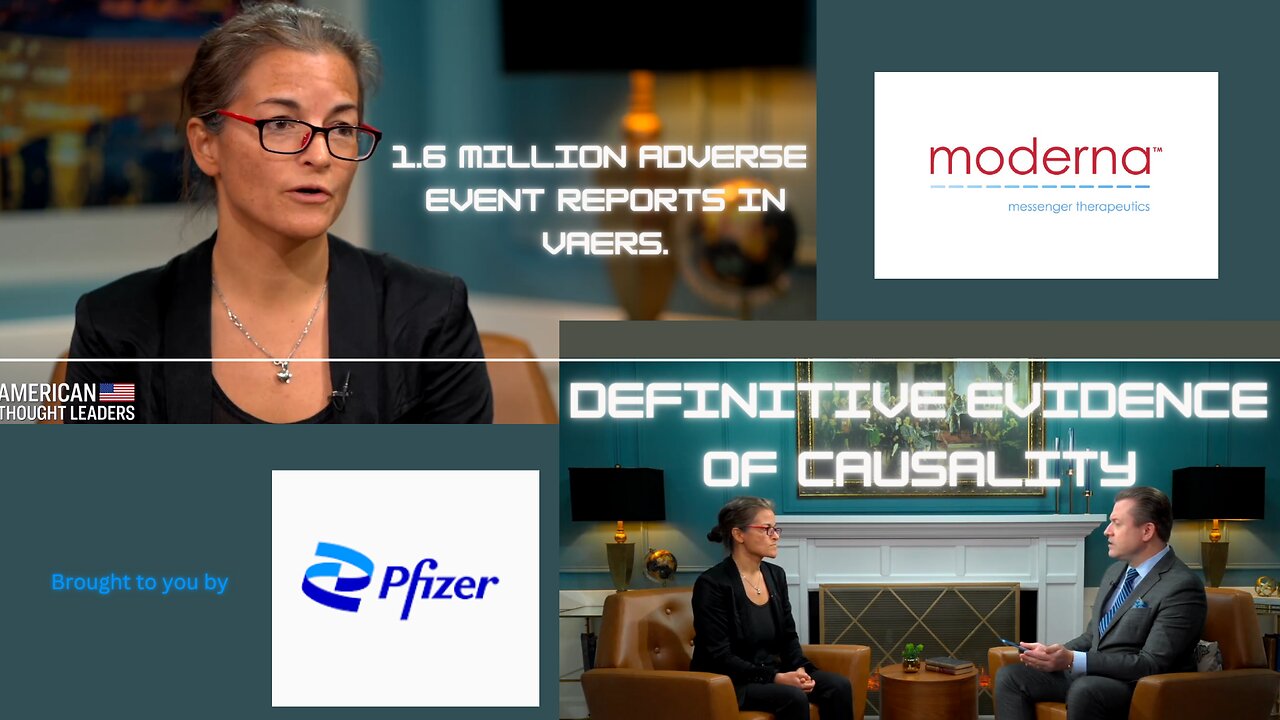Premium Only Content

Jessica Rose Breaks Down 1.6 Million VAERS Reports: "Definitive Evidence of Causality"
Aired March 7, 2024.
Buy me a coffee if you want to support this channel:
https://www.buymeacoffee.com/fanaticvoyage
[FULL TRANSCRIPT BELOW]
“We’re up to over 1.6 million reports in VAERS in the context of these products ... The numbers keep going up,” says Jessica Rose, an immunologist and independent researcher.
She recently co-wrote a paper examining the data surrounding the COVID-19 vaccine adverse events. It was the first published paper to call for a global moratorium on the COVID-19 genetic vaccines.
But a few weeks later, the journal Cureus decided to retract the paper.
Views expressed in this video are opinions of the host and the guest, and do not necessarily reflect the views of The Epoch Times.
FULL TRANSCRIPT
Jan Jekielek:
Jessica Rose, such a pleasure to have you on American Thought Leaders.
Dr. Jessica Rose:
Thanks for having me. It’s wild to be here.
Mr. Jekielek:
You had a really remarkable testimony today in the U.S. Senate. You were talking about VAERS [Vaccine Adverse Event Reporting System] data. You have a number of published papers in circulation, but recently one of them has been retracted. The paper in question is “Covid-19 mRNA Vaccines: Lessons Learned from the Registrational Trials and Global Vaccination Campaign, published in January 2024. Many people have read this paper. I’ve seen YouTube videos of people saying, “I was wrong,” as they go through this paper. It’s really impactful.
Dr. Rose:
First of all, thanks for the compliment on the testimony today. Yes, this is a paper that was spearheaded by Nathaniel Mead and other serious authors, including myself. It was the very first published paper that called for a moratorium on the modified mRNA products based on their content. That’s why eventually there was a call for retraction, because they don’t really want a moratorium placed on these products. We were issued a notice about nine days ago that we had seven days to respond to a list of bullet points that was basically empty as to why the paper should be retracted.
We pushed back a lot. We went to the social media world. We asked everybody to download the paper in case it was retracted. It wasn’t a result of that, but it helped that it is the most downloaded paper ever on the Curious platform. It has one of the highest ranking SIQ [Scholarly Impact Quotient] scores, which is a rating system of papers. It’s like a peer review process after it’s published, and it got a 9.3 out of 10. I was actually optimistic that they would not go ahead with the retraction, because it looks better for their journal to keep it up, but they went ahead just now.
Mr. Jekielek:
Let’s look at the substance of the paper first, and then try to understand why it was taken down.
Dr. Rose:
It’s basically a reinvestigation of a lot of the data, the clinical trials with Pfizer, and the Cleveland Clinic study that shows that the more Covid shots you get, the more Covid is associated, and of other published literature about IgG4, which is a tolerance antibody. I was a contributing author, and my role was to demonstrate the same story, that we’re seeing damages from these shots using VAERS data.
There’s a chart that I showed at the hearing today that is very compelling. It shows a much higher fold increase in reporting of myocarditis in 15-year-old boys following dose 2. It’s one of the criteria that you need to satisfy in order to show causality, to show cause and effect. There is not a lot of admission that these shots are causing not just myocarditis, but also the over 14,000 other reported adverse event types in VAERS.
It was a reinvestigation of a number of points where the regulators and the pharmaceutical companies are saying, “There’s no problem here.” But we found problems with every one of them, and we documented this in a paper.
Mr. Jekielek:
I might add, it was peer-reviewed under duress,
because we know how little interest there is in these kinds of findings, and then it was published.
Dr. Rose:
Yes, and not only that, but this was the journal where we went through seven reviewers, multiple editors of peer review. But before that, there were a number of other journals where we had gone through this process with reviewers, editors, and then at the last minute, which is another tactic, they say, “No, we’re not going to publish it.”
You go through months of this process, and then they say, “No, we don’t want to do it.” There were multiple rounds of that. This has not been peer-reviewed just once, it’s been peer-reviewed many times. Then they finally accepted it, so it doesn’t look good that they retracted it afterwards.
Mr. Jekielek:
They probably deserve some credit for accepting it in the first place.
Dr. Rose:
That’s a good point. The person who called for the retraction doesn’t have any science background. I don’t even know who this person is, and I’m not sure of their connection to the journal, to Curious, to PubMed, or whoever else they have to answer to in order to call for a retraction. I’m not even sure it has anything to do with the journal, to be honest with you. It’s crazy that this is happening. It’s not happening just to me, but to many people who are speaking facts and truth about what is actually going on.
Mr. Jekielek:
This journal is still available in its entirety, your paper is just marked redacted. We checked just before we started this episode. Let’s go back to the VAERS data. We were looking at this a couple of years back. We knew that the reporting on VAERS was off the charts for this product compared to all other vaccine-type products from the past. You’ve meticulously put this together for this hearing. Please tell us what you found.
Dr. Rose:
Yes, that’s been my meat through all of this. For anyone watching who doesn’t know who I am, I actually have a background in immunology and biochemistry.
Mr. Jekielek:
Then let’s take this opportunity to hear about your background.
Dr. Rose:
I’m basically a mathematical biologist with a specialty in deadly viruses. That’s not for any particular reason, it’s just that I’m fascinated by everything in nature. I started in applied mathematics, where I learned to use mathematical modeling to look at viral kinetics. I proceeded on to an immunology degree, where I did some studies on HIV immunopathology and immunopathogenesis. That was interdisciplinary, so I was working in the math department, and also a Level 3 lab, which was very exciting.
Following that, I got an invitation to study in Israel to do my PhD in
computational biology, which was more data-oriented. It was all by computer modeling, but it gave me my first taste of finding patterns in big data sets; finding something here, and finding something there. I remember all that when I’m looking at VAERS data. I did a molecular biology postdoc, looking more at bacteria than viruses. Then I did another postdoc in protein biology, and it’s amazing how all these things combined.
Mr. Jekielek:
It’s like you were made for this project.
Dr. Rose:
In my last postdoc, I needed to know about protein binding to epitopes, not just antibodies, and also how receptors work. We hear a lot about ACE2, which is the receptor that the spike protein binds to. This all came together to give me a quick understanding very early on that what we were being told was not true.
That’s what led me to look at VAERS. I said, “Once they start with this one-shot deal, we’re going to start seeing pharmacovigilance databases fill up.” I chose VAERS because you can download the data easily. It started right away in January. You could see a safety signal for death.
Mr. Jekielek:
That was January 2021, just as a reminder to everyone.
Dr. Rose:
I showed a chart today where there’s over 600 deaths on January 30th, 2021. Those are just the ones that we can see. It doesn’t include underreporting.
Mr. Jekielek:
This is not day one, but it’s very early on. VAERS is a system where you can see a signal, but it’s not definitive. These events are submitted voluntarily by people or medical professionals. What was that data supposed to mean?
Dr. Rose:
It meant that people who are older, in very short temporal proximity to being injected, were dying in association with the shots. You have to do a causality assessment following that in order to make a determination, but that’s the signal. You can compare it to historical data, to other vaccines, and to other age groups.
You can do all these sub-analyses to generate a pretty clear picture of what’s going on. People shouldn’t be dying in excessive numbers that would never have been accepted before the Covid era at the hands of a therapeutic that’s supposed to save them from death, which was the whole story.
Mr. Jekielek:
Can you compare this to another vaccine safety signal?
Dr. Rose:
You can look at the flu vaccines. Go back to 2019, take the same number of days of administration of the product, and then look at that year’s data. The difference between that year of 14 influenza vaccines vs. 2021 with three Covid products, the Pfizer, Moderna, and Janssen, was a hundredfold difference for death. This is per million doses, but it’s not because of the number of shots. This is really important for people to know. The agencies say, “It’s only because we gave out so many shots.” Yes, they gave out 2.3 times as many shots in that timeframe, but if you normalize it per million doses, there is a huge discrepancy.
Mr. Jekielek:
The bottom line is the likelihood of death associated with a Covid shot, not causal, just in close proximity, was a hundred times more than the flu vaccine a couple of years prior.
Dr. Rose:
That’s right, and that’s just the flu. You can compare it to all the vaccines combined going back 30 years.
Mr. Jekielek:
What would normally happen in such a situation?
Dr. Rose:
That’s what I talked about today in the hearing. There are standard operating procedures and causality assessments that are a part of that. You can use proportional reporting ratio analyses. You can use Bayesian analysis, which is not my ballpark. You can use Bradford Hill criteria, which is the standard for looking into epidemiological data to see if there’s a causal connection of a drug, pharmaceutical product, or biological to a particular side effect.
Mr. Jekielek:
I wasn’t aware of this set of criteria, but now I’m more familiar with it, partially because of your work.
Dr. Rose:
Yes, this is the standard, and they’ve always done that. To give you a specific example, in 1999, there was a signal emanating from VAERS. It was a lower signal for intussusception, which is folding over of the bowel, than we saw for death from the Covid shots in January, 2021. They did their causality assessment using Bradford Hill, and it was determined by satisfying 6 out of the 10 points that there was a very likely cause-effect relationship, so that rotavirus product was immediately pulled from the market.
That’s normally what happens. There’s something really different about the Covid-19 products. It’s like no matter how much of a signal you see for any adverse event, there’s no way these things are going to get pulled from the market.
Mr. Jekielek:
Presumably, you ran the Bradford Hill criteria on that same data set from early on, the 600 cases. How does that stack up?
Dr. Rose:
There are 10 criteria, and I satisfied all 10.
Dr. Jessica Rose: (U.S Senate testimony)
Fact: The Bradford Hill criteria are used to assess causality in epidemiological data, such as the VAERS pharmacovigilance system.
Fact: The proportional reporting ratio is used to assess whether or not a particular adverse event is more commonly reported in the context of a particular drug. If the PRR [Pattern recognition receptor] is greater than one, a causal effect is indicated.
Fact: The PRR calculation for death from VAERS in the context of the Covid-19 shots, using current VAERS data, is 3.6.
Fact: The underreported number of deaths successfully filed to VAERS by January 20, 2021, was 634. Based on historical guidelines, this was sufficient as a signal, not only to prompt an investigation, but to shut down the rollout of the Covid-19 shots.
Fact: In 1999, a rotavirus vaccine designed to prevent rotavirus gastroenteritis was pulled from the market due to an intussusception signal emanating from VAERS, which comprised 584 cases.
Question: If 584 cases of intussusception were enough to prompt
product removal, then why weren’t 634 cases of death not enough to prompt Covid-19 product removal?
Fact: The early death count was hidden.
Fact: Currently, 1,615,998 deaths have been successfully filed to VAERS in the context of the Covid-19 injectable products, with a staggering 1,013,442 reports filed in 2021 alone, when considering both the foreign and domestic data sets. The number of adverse events reported to the domestic VAERS data set for all vaccines combined has been on average 39,000 in total per year, and has been very slowly and steadily increasing in direct proportion to the increasing number of vaccine products on the market. See slide one.
In 2021, however, a 1,417 percent increase in reporting occurred, whereby 93 percent of these reports were in the context of the Covid-19 products.
Fact: Age is not deterministic for adverse event reporting. Since administration of the Covid-19 products to the 0 to 4 age groups commenced, the rate of adverse event reporting has been increasing faster than for any other age group.
Fact: The argument that this spike in reporting is due to increased shot administration is false. Slide two shows the comparison of the number of adverse events per million doses in the context of influenza vaccines and the Covid-19 injectable products in 2019 and 2021, respectively. On the left are the total adverse events, on the right are the deaths.
The Covid-19 injectable products are associated with a 26 and a 100-fold increase in the number of adverse events per million doses. The number of adverse events in total adverse events and deaths, respectively, when compared per million doses with influenza vaccines in the same time frame.
Fact: The Bradford Hill criteria reversibility is satisfied. When a drug is withdrawn, the side effects disappear. A strong correlation of R = 0.8 and a high covariance exists between shot rollout data and myocarditis reports filed according to Our World in Data, new vaccination data,
and VAERS data, respectively. As shot demand wanes, so do the myocarditis reports. See slide 3a.
Fact: The Bradford Hill criterion’s specificity is satisfied. A very specific population at a specific site and disease is reported with no other likely explanation. Dose two is associated with a fourfold increase in reporting of myocarditis in 15-year-old boys. This indicates specificity with regard to age and gender. See slide 3b.
Fact: The Bradford Hill criterion’s dose report is about response is satisfied. Greater exposure leads to greater incidence of the effect. Following dose
two, an increase in signal occurs. See slide 3b.
Fact: Myocarditis is not transient or mild. A new paper published by Rose et al. in the journal Therapeutic Advances in Drug Safety shows that myocarditis is associated with hospitalization in 76 percent of reports. There are seven more Bradford Hill criteria that are satisfiable. That’s a 10 out of 10. Bingo.
Conclusion: Standard operating procedures for analysis of safety signals emergent from VAERS when utilized reveal causal links between the Covid-19 injectable products and the adverse events investigated. Standard operating procedures are not being followed by the owners of the data, namely CDC, HHS, and FDA. And this equates to hiding the millions of people reporting not only adverse events, but injuries in the context of the Covid-19 injectable products.
Dr. Rose:
It’s not just the VAERS data. There’s evidence from Pfizer’s own clinical trials that satisfy some of these. With the proportional reporting ratio, it’s a pretty easy calculation for death. As of today, in VAERS, it is 3.6. These aren’t my tests, these are their tests. If it’s anything over one, it indicates that there’s a problem, a causal effect. There’s not just an indication from two causality assessment types.
I have colleagues in the UK who are Bayesian analysis experts, and they also analyzed it. They took it upon themselves because no one who owns the data was doing it. They also found that there’s a clear signal here. The onus is on the owners of the data and the people who are in charge of regulating the products to ensure that the public is not getting something poisonous, but they’re not doing it.
Mr. Jekielek:
Who are the owners of the data?
Dr. Rose:
It’s HHS [U.S. Department of Health and Human Services] and the CDC [Centers for Disease Control and Prevention]. I’m not sure if the FDA is an owner, but they’re affiliated. They’re the regulators.
Mr. Jekielek:
You’re saying that in the first month of vaccine deployment, the signal is very clear, with all 10 points of the Bradford Hill criteria, and these things don’t get pulled. What does that look like now? There have been a lot more VAERS entries since then.
Dr. Rose:
Yes, it’s the same story and it hasn’t changed. Even this endocarditis chart where you plot the cases according to age and dose, it hasn’t changed over the years. It has been years now, which is hard to believe. We’re up to over 1.6 million reports in VAERS in the context of these products. Yes, the numbers keep going up.
It’s not just because data is being retroactively added to the front end system. Reports are still coming in and that’s concerning because it signifies a delayed effect in the arrival of an adverse event. When you think about autoimmune conditions and cancer, that makes sense because they’re not going to manifest in everyone at the same time.
Mr. Jekielek:
Presumably, there’s more reports now when there’s an event and the health professional connects the two for some reason, but that’s harder to see. Because it’s close proximity, there’s a good chance these things are related. Do you have a sense of how that works and how, why are people seeing that connection?
It’s a situation where 70-odd percent of the reports filed to VAERS are filed by medical professionals. You’re suggesting that some of them are likely people who should have filed them a couple of years back and now they think, “Okay, it’s time, I better do this. The pressure is on.”
Dr. Rose:
I always thought there was going to be a tipping point of being able to hide the bodies, let’s just put it that way. But just in one database, we’re into millions of reports. We’re not talking about UDRA [Unified Data Reference Architecture], or Yellow Card. We’re not talking about all these other systems that are showing the same thing. When you think about the world and the fact that billions of people were injected with this stuff, it’s not underestimating to think in the hundreds of millions.
If you’re a doctor, you took the Hippocratic Oath at one point in your life. Even if you have been indoctrinated and had all of this pressure coming down from your hospital that gives you your paycheck, that has to turn at some point. Your ethics and your humanness has to kick in at some point.
Maybe I’m being hopeful, but I think that is playing a role. Despite the suppression of information, people file reports and they’re hearing more about their neighbor getting injured or their mom getting injured. They’re hearing something about it.
Mr. Jekielek:
One of the arguments being made is that there might be over-reporting.
Dr. Rose:
Yes. If you want to play that game, okay, it’s over-reported. But guess what? VAERS is also severely under-reported, so at the very least, those things would balance out. Let’s throw both of them away and look at the absolute counts. It’s still a horror show, even if you include the under-reporting factor.
Mr. Jekielek:
What is the under-reporting factor?
Dr. Rose:
It depends. It probably is a little bit higher because there is more awareness now and everybody on planet earth knows about Covid now. But it’s going to depend on the adverse event, because obviously, fever and chills are not going to be reported at the same frequency as death. You would think death is reported more, so it’s going to vary. To give you a number, I calculated 31 as an under-reporting factor for severe adverse events, which does include death.
Mr. Jekielek:
That would mean that for every 31 instances, there would be one report.
Dr. Rose:
Or any number you hear me quote, you have to multiply by 31. When you’re talking about hospitalizations or disability, you have to multiply.
Mr. Jekielek:
How did you do that calculation?
Dr. Rose:
I used the Pfizer phase three clinical trial data where they calculated the severe adverse event rate, which was 0.7 percent. I balanced that against the number of reports in VAERS. I did the calculation that way, so yes, it could be 31. It could be close to that.
Mr. Jekielek:
I’ve also heard the number 30. It’s interesting to see it in some of the general calculations that were done in the past.
Dr. Rose:
A number of people have done calculations to estimate it and our numbers aren’t that different. It’s a good approximation if you want to just do the math in your head to find out how many actual people are suffering instead of reporting.
Mr. Jekielek:
In terms of VAERS reports, how do those reports compare to the past use of the system?
Dr. Rose:
VAERS has been on the go for 30 years, so go back to 1990 to find the average number of reports filed for all vaccines combined. You’re probably well aware that the number of vaccines has been steadily increasing over the past 30 years. It’s around 39,000 reports for all vaccines combined with a very slight increase over the past 30 years.
The increase is proportional to the increase in the number of products on the market until 2021. In 2021 alone, with three products, it’s about a million. You’re comparing 39,000 for a 30-year stretch with a million in 2021. It’s not comparable. I call it the bungalow skyscraper plot.
Mr. Jekielek:
What about just in terms of the raw number of shots given over those 30 years, vs. that one year? They say it’s 1.2 billion people. I don’t know what the number would have been for all those other vaccines.
Dr. Rose:
It’s pretty high. I don’t know the exact number, but I looked at the flu. If you compare 2019 to 2021 within something like a 465 day timeframe, it’s 2.3 times as many shots given out for the Covid shots. If there wasn’t anything more dangerous or injurious about the Covid shots, you would anticipate, based on the slope for the past 30 years, that there would be a proportional increase in reporting, not a 1400 percent increase.
Mr. Jekielek:
Right. The bottom line is that VAERS is supposed to be the signal. What normally happens when that signal appears? You mentioned one instance where the product was pulled very quickly once there was a significant number. Typically, what is the process?
Dr. Rose:
They are constantly monitoring the safety signals. This is another good point to make because we know that they’re monitoring this data. It’s their data. I might add that the front end downloadable VAERS data is a much smaller data set than the one that they have access to. They have all the reports that have been filed. Then they vet them, then put them on the front end server, and they also have more demographic data.
They know what’s going on. If they consider that a signal has risen, then they do these analyses that I mentioned before. Because in the interest of public health, which I thought this was all about, they would respond if there was a signal of danger associated with these products.
Mr. Jekielek:
What do you think is going on?
Dr. Rose:
It was necessary to get the modified mRNA LNP platform into as many people as possible to see what would happen, and it had to succeed. They had to get into as many arms as possible as a segue for what’s coming next, which is gene therapy. That’s what I think. The idea is that if enough people survive and are okay, or at least it looks that way, then they will use the idea, which is absolutely false, that the platform is now plug and play.
Instead of introducing the coding material for the spike protein, it will be for another disease. They will say, “All we have to do is change the genetic code. Since it was so safe and effective, we can just use it for this disease.” I think that will be probable.
Mr. Jekielek:
That’s an interesting hypothesis. Is this a data set that they’re going to use to try and correct the technology? There was a frame shifting paper in one of the Nature sub-journals. One of our Epoch Times reporters was talking to you in reference to a substack you wrote about it.
There are multiple flaws in the technology. There are unknown proteins that are being created because of this introduction of the pseudouridine base. Please tell us about the substack you wrote on this.
Dr. Rose:
This is an important thing to talk about. This is really new. Health Canada, just for some background, is aware of a multitude of things, because of people independently studying and publishing about DNA contamination in the modified mRNA products, which isn’t supposed to be there. There’s a paper published in Nature, the highest ranking journal, about something called frameshifting. You don’t really need to know what that is.
But the byproduct is that the on-target proteins, which are supposed to be the spike protein manufactured by your cells, are not the only proteins being produced, because of this shift in the frame of the translation. What we’re getting about 8 percent of the time are off-target proteins, and nobody knows what they are, and nobody knows what they do.
But if you know a little bit about the process of translation in mRNA, something that can go wrong is the misfolding of proteins when they exit this ribosome, the machine that performs the translation. Misfolded proteins are a very bad thing because they can behave erroneously. You hear a lot about prion diseases, so this is the association.
We do see quite a few reports of prion-like diseases, so it’s possible that this is the mechanism of action. Maybe in some people’s cells, off-target proteins are being produced too much of the time, and protein misfolding is occurring, and we’re getting these prion-like illnesses. It’s just a possibility.
But yes, someone sent Health Canada an email about this article that I wrote, which basically just explained what the Nature paper described. Health Canada then said, “What are we going to do about this problem? We have to respond to this because people are going to read that and they’re going to get freaked out.” It was quite strange to see my name on these FOIA requested emails.
The bottom line is, even though there was concern from some of the people, it was ultimately voted on as not being a safety issue, which is nonsense. You can’t state that unless you have data to back up that it is either safe or unsafe.
We don’t know anything about it. We don’t know whose cells are being corrupted to produce aberrant proteins. We don’t know what percentage of the time. We don’t know the impact. We don’t know what the proteins are. It’s ludicrous for anybody who knows anything about this to state that there is no potential danger. This is weird because this is their job.
Mr. Jekielek:
This 8 percent of the time is just in this particular study, but we haven’t actually seen what’s happening.
Dr. Rose:
Yes. We just need to talk more and more about this and ignore the fact that somebody’s product isn’t going to be profitable, because we’re literally talking about the well-being of our species here. I know that sounds dramatic. There are billions of people injected with these things who have a plethora of problems right now.
Maybe that’s why we’re only seeing adverse events in a certain percentage of people right now. Maybe some of them are having this problem and others are having that problem. It could be DNA contamination, or maybe somebody had a defective BRCA gene already.
Mr. Jekielek:
There are multiple areas which are problematic. This was discussed in the hearing today. People brought up the fact that the lipid nanoparticle itself has a toxicity. That’s just one example. The conclusion of your paper that got retracted was that we shouldn’t be using these products.
Dr. Rose:
I’m really glad you brought that up, because this lipid nanoparticle-based technology called Onpattro has been on the market. It’s basically the same composition lipid nanoparticle as used in the Pfizer Moderna products. It has a molecule embedded on its surface that allows it to target hepatocytes in the liver.
I won’t give you the names because it doesn’t matter. This is all out there, and we know about it. They claim that when injecting this same lipid nanoparticle into the arm that it’s going to stay there. That’s nonsense. It never could have been that way. This is a specific example of a product that was designed using lipid nanoparticle technology to go directly to the liver.
We don’t know because they won’t disclose exactly what these lipid nanoparticles might have been coated with if they were specifically targeted to go somewhere. Maybe they were specifically targeted to the heart. I’m not saying that I believe that, but it’s important as a researcher and a scientist to ask these questions.
Mr. Jekielek:
Maybe they tried to not have them coated, or maybe we just don’t know.
Dr. Rose:
We just don’t know, and that’s a huge problem.
Mr. Jekielek:
But someone does know.
Dr. Rose:
You would think so. They have researchers and developers and they’re brilliant. They must be, because they’re doing incredible things. To me, as evil and horrible as it is, it’s still kind of incredible. It’s just that nobody should have been injected with these things, as incredible as the concept or the technology might be, because the damage that might ensue is so severe.
Mr. Jekielek:
It’s interesting that you mentioned targeting the heart. You have this other recent paper that’s also that focuses on the determinants of myocarditis.
Please tell us what you found.
Dr. Rose:
Yes. You’ve heard the story that the narrative holders are committed to, that myocarditis, although it’s a problem in a small number of people, is mild and transient. No cardiologist would ever stand behind that if they had any ethics. It’s not. It is the scarring of your myocardium, which is the elastic part of your heart that allows it to beat. That is not a good thing because scar tissue isn’t flexible, especially if you’re a young person and your heart is still growing.
In 76 percent of the reports of myocarditis in VAERS, regardless of age, hospitalization was co-associated. That doesn’t sound mild to me. I don’t buy that it’s transient either because it’s definitely going to depend on the degree of inflammation and residual or subsequent scar tissue. I’m not a cardiologist, so I can’t really say a lot about it.
But I have a good imagination. If you are a 15-year-old boy, if you sustain even a small amount of scar tissue on your heart, that’s not going to bode well for you when you’re talking about the number of years you have left in life.
Mr. Jekielek:
Myocarditis never completely goes away. You have to be careful for the rest of your life. That’s what doctors would have told you.
Dr. Rose:
Yes. Peter McCullough talks about the adrenaline surge that we all have at night when we’re sleeping. This is why a lot of people are dying in their sleep from cardiac issues, because they have sustained damage to their heart, probably myocardial damage, and they have that adrenaline surge. That’s the worst thing that can happen for you if you have heart damage. It explains it really well, because when you’re pumping your heart really hard, that’s also an adrenaline surge.
Again, I’m not a cardiologist. But if you sustain an injury like myocarditis, you are told not to exert yourself for a certain amount of time to prevent that combination of damage and adrenaline surge from killing you.
Mr. Jekielek:
As we finish up, where are we today with this situation?
Dr. Rose:
We are not much further along in terms of doing proper assessment and following standard operating procedures. Even getting a paper that’s been very well received and peer reviewed and published, and then getting it retracted is now a badge of honor. It goes hand in hand with the fact that more and more people know that something is wrong. Most people were coerced into getting the shots because they had their jobs threatened. They knew somewhere in their heart or mind that something was wrong. Now, it’s definitive.
There’s enough wisdom in the human species now to have the power to say no the next time something comes up. You know all about disease X that is on the horizon. Yes, we have to brace for impact. I’m optimistic that we are ready, which is not to say we don’t have a hellish battle ahead of us, because they’re very powerful.
Mr. Jekielek:
What if there really is a huge problem?
Dr. Rose:
You mean like an actually dangerous disease? That’s a good point and a really hard thing to answer.
Mr. Jekielek:
It’s kind of like a crying wolf thing now.
Dr. Rose:
Yes. It’s a really good thing for everyone to think about. What I would do is to use common sense. If you think that there’s a pending threat from a hemorrhagic fever, because no one wants to get a hemorrhagic fever, just use common sense. Lay low for a bit and don’t go out to the malls and sneeze on people and get sneezed on. It’s the same things your parents used to tell you about not being exposed to any kind of pathogen.
Nobody ever talks about vitamin D. If your immune system is intact, even if you’re faced with something that might be considered a hearty fight for your immune system, if you are optimized with a sufficient level of vitamin D, you’re probably going to do okay. Our bodies are pretty amazing and our immune systems work really well. We don’t actually need vaccinations or inoculations to maintain health. We can live fine without them.
I would encourage people to be calm, use common sense, and take really good care of your body every day. That is an everyday thing. It means good water, good food, exercise, sunshine if you can get it, and supplements if you can’t.
Mr. Jekielek:
Dr. Jessica Rose, it’s such a pleasure to have you on the show.
Dr. Rose:
My honor. It’s been really great.
Mr. Jekielek:
Thank you all for joining Dr. Jessica Rose and me on this episode of American Thought Leaders. I’m your host, Jan Jekielek.
This interview has been edited for clarity and brevity.
Buy me a coffee if you want to support this channel:
https://www.buymeacoffee.com/fanaticvoyage
Tags for this video:
Jan Jekielek, Jessica Rose, Dr. Jessica Rose, Dr. Rose, Jekielek, Adverse Event Reports, Evidence of Causality, VAERS, Covid products, Bill Gates, Bourla, Pfizer, Moderna, Vaccine, Vax, Jab, mRNA Vaccines, mRNA, mRNA Covid-19 vaccines, CEO, Rockerfeller Foundation, Bill and Melinda Gates Foundation, GAVI, Vaccines, GAVI, Vax, Jab, Genocide, Global Vaccination, Adverse effects, covid mandates, covid restrictions, lockdown, Pandemic measures, Patents, Vaccine Technology, mRNA Technology, modRNA, siRNA, Epoch Times, Epic, Epoch TV, American Thought Leaders, Show, Statistics, 2019, 2023, 2024, March 7, AE, Side effects, reported, mortality, numbers, doctors, medicalprofessionals, Government, Data, Causality,
-
 1:17:34
1:17:34
Mike Rowe
7 hours agoA Masterclass In The Collapse Of Woke Culture With Anson Frericks
41.8K34 -
 17:51
17:51
Stephen Gardner
7 hours ago🔥YES!! Trump CUTS CORD on Democrats SECRET PROGRAM!
68.8K55 -
 2:16:49
2:16:49
TheSaltyCracker
7 hours agoMusk Destroys Gov't Money Pot ReeEEeE Stream 02-05-25
137K241 -
 1:10:59
1:10:59
FreshandFit
7 hours agoTop 3 Ways To Overcome A Break Up
74K7 -
 6:32:11
6:32:11
Akademiks
8 hours agoDrake Finally CUTS off FAKE FRIENDS in the Industry. VIOLATES KHALED, LEBRON! Announces album Feb14
68.7K11 -
 27:28
27:28
Glenn Greenwald
11 hours agoGlenn Reacts to Trump's Gaza Take Over: System Update Special
174K299 -
 2:13:49
2:13:49
Melonie Mac
8 hours agoGo Boom Live Ep 36!
92.5K9 -
 1:02:11
1:02:11
Sarah Westall
8 hours agoFreezing USAID & its Operations in Ukraine: A Massive Money Laundering Organization? w/ Sam Anthony
84K17 -
 2:05:35
2:05:35
Space Ice
12 hours agoSpace Ice & Redeye: Neil Breen's Pass Thru
34.5K1 -
 1:00:23
1:00:23
The StoneZONE with Roger Stone
8 hours agoRoger Stone Talks Trump’s Electric First 100 Day Agenda | The StoneZone w/ Roger Stone
39.3K8